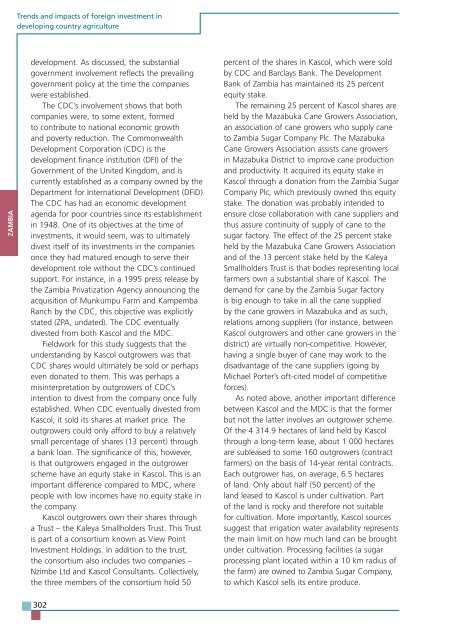TRENDS AND IMPACTS OF FOREIGN INVESTMENT IN DEVELOPING COUNTRY AGRICULTURE
TRENDS AND IMPACTS OF FOREIGN INVESTMENT IN DEVELOPING COUNTRY AGRICULTURE
TRENDS AND IMPACTS OF FOREIGN INVESTMENT IN DEVELOPING COUNTRY AGRICULTURE
You also want an ePaper? Increase the reach of your titles
YUMPU automatically turns print PDFs into web optimized ePapers that Google loves.
ZAMBIA<br />
Trends and impacts of foreign investment in<br />
developing country agriculture<br />
development. As discussed, the substantial<br />
government involvement reflects the prevailing<br />
government policy at the time the companies<br />
were established.<br />
The CDC’s involvement shows that both<br />
companies were, to some extent, formed<br />
to contribute to national economic growth<br />
and poverty reduction. The Commonwealth<br />
Development Corporation (CDC) is the<br />
development finance institution (DFI) of the<br />
Government of the United Kingdom, and is<br />
currently established as a company owned by the<br />
Department for International Development (DFiD).<br />
The CDC has had an economic development<br />
agenda for poor countries since its establishment<br />
in 1948. One of its objectives at the time of<br />
investments, it would seem, was to ultimately<br />
divest itself of its investments in the companies<br />
once they had matured enough to serve their<br />
development role without the CDC’s continued<br />
support. For instance, in a 1995 press release by<br />
the Zambia Privatization Agency announcing the<br />
acquisition of Munkumpu Farm and Kampemba<br />
Ranch by the CDC, this objective was explicitly<br />
stated (ZPA, undated). The CDC eventually<br />
divested from both Kascol and the MDC.<br />
Fieldwork for this study suggests that the<br />
understanding by Kascol outgrowers was that<br />
CDC shares would ultimately be sold or perhaps<br />
even donated to them. This was perhaps a<br />
misinterpretation by outgrowers of CDC’s<br />
intention to divest from the company once fully<br />
established. When CDC eventually divested from<br />
Kascol, it sold its shares at market price. The<br />
outgrowers could only afford to buy a relatively<br />
small percentage of shares (13 percent) through<br />
a bank loan. The significance of this, however,<br />
is that outgrowers engaged in the outgrower<br />
scheme have an equity stake in Kascol. This is an<br />
important difference compared to MDC, where<br />
people with low incomes have no equity stake in<br />
the company.<br />
Kascol outgrowers own their shares through<br />
a Trust – the Kaleya Smallholders Trust. This Trust<br />
is part of a consortium known as View Point<br />
Investment Holdings. In addition to the trust,<br />
the consortium also includes two companies –<br />
Nzimbe Ltd and Kascol Consultants. Collectively,<br />
the three members of the consortium hold 50<br />
302<br />
percent of the shares in Kascol, which were sold<br />
by CDC and Barclays Bank. The Development<br />
Bank of Zambia has maintained its 25 percent<br />
equity stake.<br />
The remaining 25 percent of Kascol shares are<br />
held by the Mazabuka Cane Growers Association,<br />
an association of cane growers who supply cane<br />
to Zambia Sugar Company Plc. The Mazabuka<br />
Cane Growers Association assists cane growers<br />
in Mazabuka District to improve cane production<br />
and productivity. It acquired its equity stake in<br />
Kascol through a donation from the Zambia Sugar<br />
Company Plc, which previously owned this equity<br />
stake. The donation was probably intended to<br />
ensure close collaboration with cane suppliers and<br />
thus assure continuity of supply of cane to the<br />
sugar factory. The effect of the 25 percent stake<br />
held by the Mazabuka Cane Growers Association<br />
and of the 13 percent stake held by the Kaleya<br />
Smallholders Trust is that bodies representing local<br />
farmers own a substantial share of Kascol. The<br />
demand for cane by the Zambia Sugar factory<br />
is big enough to take in all the cane supplied<br />
by the cane growers in Mazabuka and as such,<br />
relations among suppliers (for instance, between<br />
Kascol outgrowers and other cane growers in the<br />
district) are virtually non-competitive. However,<br />
having a single buyer of cane may work to the<br />
disadvantage of the cane suppliers (going by<br />
Michael Porter’s oft-cited model of competitive<br />
forces).<br />
As noted above, another important difference<br />
between Kascol and the MDC is that the former<br />
but not the latter involves an outgrower scheme.<br />
Of the 4 314.9 hectares of land held by Kascol<br />
through a long-term lease, about 1 000 hectares<br />
are subleased to some 160 outgrowers (contract<br />
farmers) on the basis of 14-year rental contracts.<br />
Each outgrower has, on average, 6.5 hectares<br />
of land. Only about half (50 percent) of the<br />
land leased to Kascol is under cultivation. Part<br />
of the land is rocky and therefore not suitable<br />
for cultivation. More importantly, Kascol sources<br />
suggest that irrigation water availability represents<br />
the main limit on how much land can be brought<br />
under cultivation. Processing facilities (a sugar<br />
processing plant located within a 10 km radius of<br />
the farm) are owned to Zambia Sugar Company,<br />
to which Kascol sells its entire produce.


